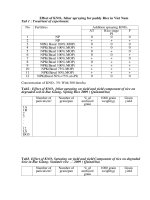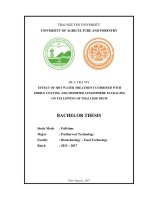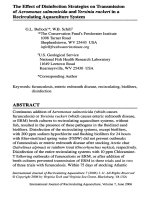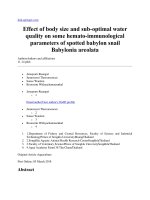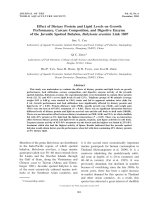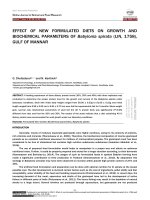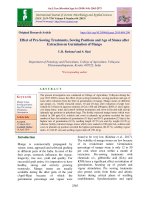Effect of pre-sowing treatments, sowing positions and age of stones after extraction on germination of mango
Bạn đang xem bản rút gọn của tài liệu. Xem và tải ngay bản đầy đủ của tài liệu tại đây (269.25 KB, 9 trang )
Int.J.Curr.Microbiol.App.Sci (2019) 8(4): 2565-2573
International Journal of Current Microbiology and Applied Sciences
ISSN: 2319-7706 Volume 8 Number 04 (2019)
Journal homepage:
Original Research Article
/>
Effect of Pre-Sowing Treatments, Sowing Positions and Age of Stones after
Extraction on Germination of Mango
U.R. Reshma*and S. Simi
Department of Pomology and Floriculture, College of Agriculture, Vellayani,
Thiruvananthapuram, Kerala -695522, India
*Corresponding author
ABSTRACT
Keywords
Mango stones,
Sowing positions,
Age, Pre sowing
Treatments,
Germination
Article Info
Accepted:
17 March 2019
Available Online:
10 April 2019
The present investigation was conducted at College of Agriculture, Vellayani during the
year 2017-2018 to assess the effect of pre-sowing treatments, sowing positions and age of
stone after extraction from the fruit on germination of mango. Mango stones of different
age groups viz., freshly extracted stones, 10 and 20 days after extraction of pulp were
soaked for 24 hours in aqueous solutions of GA3 (100 and 200 ppm), KNO3 (1 and 2 ppm),
cow dung slurry, water and control (without treatments) and sown in flat and stalk end up
(plumule up) positions in polythene bags. The freshly extracted mango stones which were
soaked in 200 ppm GA3 solution and sown in plumule up position recorded the least
number of days for initiation of germination (13 days) and 50 % germination (23 days), the
highest rate of germination (0.74), seedling length (27.35 cm) and dry weight (10.70 g)
whereas freshly extracted mango stones which were soaked in 100 ppm GA3 solution and
sown in plumule up position recorded the highest germination (82.22 %), seedling vigour
index -I (2142.03 cm) and seedling vigour index-II (791.48 g).
Introduction
Mango is commercially propagated by
veneer, stone, approach and softwood grafting
in different parts of the India. In most of the
fruit crops, rootstock influences the vigour,
longevity, tree size, yield and quality. For
successful graft union, it is imperative to have
healthy, strong and actively growing
rootstocks. Mango stones are usually
available during the drier parts of the year
(April-May) because
of which the
germination percentage and vigour were
found to be very low (Kolekar et al., 2017).
The viability of mango stones are low because
of its recalcitrant nature. Germination
percentage of mango stone is only 12 to 50
per cent when sown within a month of
extraction. Pre-sowing treatments with
chemicals viz., gibberellic acid (GA3) and
KNO3 have a significant effect on initiation of
germination, boosting up of growth and
vigour stimulation. Pre sowing treatments
also protect seeds from biotic and abiotic
factors during critical phase of seedling
establishment. Synchronization and rapid
2565
Int.J.Curr.Microbiol.App.Sci (2019) 8(4): 2565-2573
seedling emergence are the commonly
reported benefits of pre-sowing treatments on
germination. The orientation of seeds on seed
bed has a great role in boosting up of the
process of germination. It has a positive
influence on altering the energy levels which
are needed for the radicle and plumule
emergence required for completion of
germination process. This is mainly due to the
quantity of stored nutrients as well as the
positioning of micropyle. The stalk end up
position of sowing helps to place the
micropyle in the most appropriate position
and resulted in minimum requirement of
energy for germination and stimulates the
metabolic process that release energy for
radicle emergence (Bewley, 1997). Age of
stone also has a crucial impact on germination
and subsequent growth. Moisture content is
the key factor that determines the viability of
recalcitrant seeds. Loss of critical moisture
content as the age advances can cause the
alterations in a series of metabolic processes
and can cause accumulation of free radicals,
which results in onset of the deterioration
process (Patil and Krishna, 2016).
An experiment was therefore undertaken to
assess the effect of pre-sowing treatments,
sowing positions and age of stones after
extraction from the fruit with the main
objectives
of
increasing
germination
percentage and producing vigorous rootstocks
in order to meet the ever rising market
demand and to evolve the best technology for
producing high quality mango planting
material in a short period of time. The study
aims to obtain information about seed
germination and seedling development that
could facilitate nursery production of mango
seedlings for orchard establishment.
Materials and Methods
The present study was carried out during 2017
– 2018 at the College of Agriculture,
Vellayani,
Thiruvananthapuram.
The
experiment was laid out in Factorial
Completely Randomized Block Design with
42 treatments. The treatments comprise of
different combinations of 2 sowing positions
(flat and stalk end up), 3 different age group
of stones after extraction from fruit (freshly
extracted stones, 10 days after extraction, and
20 days after extraction) and 7 pre-sowing
treatments, GA3- 100 and 200 ppm, KNO3 -1
and 2 ppm, cow dung slurry, water and
control. Fruits of ‘Kotookonam Varikka’
variety of mango were selected for stone
extraction and were procured from southern
tracts of Thiruvananthapuram, district of
Kerala. The stones were washed thoroughly to
remove extraneous material adhering to it.
These stones were immersed in water and
allowed to settle at the bottom of the
container. Stones floating on the surface of
water were discarded and those which settled
at the bottom were used for experimentation.
The mango stones were soaked in the above
solutions for 24 hours prior to sowing during
different times after extraction based on age
groups. The resultant forty two treatments
were replicated thrice. Treated mango stones
of different age groups were sown in two
different methods viz., stalk end up and flat
positions.
The germination percentage was calculated
using the formula given below;
Germination percentage =
Number of germinated stones x 100
Total stones
The rate of germination was determined by
dividing the germination percentage with
number of days taken for attaining the
germination. The seedling vigour index-I was
calculated by multiplying germination % and
seedling length, while the seedling vigour
index II was determined by multiplying
germination % and dry weight of seedling.
2566
Int.J.Curr.Microbiol.App.Sci (2019) 8(4): 2565-2573
Five mango seedlings were selected at
random from each replication for recording
observations related to germination. The
germination of stones started 15 days after
sowing and continued upto 55 days.
Observations were recorded daily for
germination parameters and vegetative
parameters like seedling length, dry weight
and seedling vigour index I & II were
recorded 4 months after sowing. The
experimental data recorded were subjected to
statistical analysis as per the method
suggested by Panse and Sukhatme (1967).
Treatment means were separated using F test
values at 5 % level of significance.
Results and Discussion
Significant differences were observed among
the pre-sowing treatments, sowing positions
and age of stones after extraction from the
fruit for germination characters. Statistically
analysed results are given in Table 1 and 2
and are explained under following subheadings.
Effect of sowing positions
There was a significant impact of sowing
positions on all the parameters chosen for this
investigation (Table 1). The stones which
were sown in stalk end up position stalk end
up position resulted in the highest
germination, minimum number of days for
initiation of germination, high rate of
germination and seedling vigour indices (on
growth and weight basis). Sowing of seeds at
proper depth and position was one of the most
important nursery operations because it
affects germination and subsequent growth.
To ensure good germination, rapid emergence
and good performance, seeds must be placed
in a position and in an environment that
ensures the availability of nutrients and water
from the soil. Seed orientation affects
seedling emergence greatly. The results are in
conformity with Garner and Chaudhri (1976)
and Hammed et al., (2014) in cashew.
Germination commences with the uptake of
water by the dry seed (imbibition) and is
completed when embryonic shoot and root,
i.e., plumule and radicle, respectively,
emerged. The amount of energy required to
accomplish this task varies with genotype and
orientation of the seed at sowing because of
the quantity of stored nutrients, especially
endosperm and positioning of micropyle.
Mango stones with stalk-end up places the
micropyle in the most suitable position, i.e.,
pointing downward, and therefore requires
less germination energy for the radicle to
emerge from the embryo. Moreover, stalk-end
facing up might enhance accessibility to
required oxygen for the initial metabolic
process that produces energy for radicle
emergence (Bewley, 1997). Improper
orientation of stones could deprive the
emerging embryo of needed oxygen which
could lead to high ethanol and pyruvate
production in the system and finally death of
the emerging embryonic (plumule and
radicle) plants. This probably resulted in the
reduced germination percentages and poor
quantitative plant vigour.
Effect of age of stones after extraction from
the fruit
The
highest
germination
percentage,
minimum number of days for initiation of
germination, rate of germination, seedling
vigour indices on growth basis and weight
basis were the best for the freshly harvested
stones (Table 1). Germination characteristics
of freshly harvested stones were the best
compared to other age group of stones
(Chaudhari and Patel, 2012). Germination
became progressively slower as the age
advances.
The
highest
germination
percentage, minimum number of days for
initiation of germination and for 50 %
germination, rate of germination, seedling
2567
Int.J.Curr.Microbiol.App.Sci (2019) 8(4): 2565-2573
length, dry weight of seedling, seedling
vigour index- I and seedling vigour index- II
were found best for the freshly harvested
stones. The results are in conformity with
Kumar et al., (2018b) in jamun.
Effect of pre-sowing treatments
The stones pre-treated with GA3 100 ppm
recorded the highest germination, whereas
GA3 (200 ppm) required minimum number of
days for initiation of germination (Table 1).
Early stone germination in GA3 200 ppm
treatment might be due to increased
endogenous auxin content due to application
of GA3. The pre-soaking treatment of GA3
might have affected and altered the enzymatic
reaction, protein synthesis and conversion of
starch to sugars involved in the germination
process (Paleg, 1960). Gibberellic acid
induces denovo synthesis of proteolytic
enzymes like α-Amylase and ribonuclease.
Amylases in turn hydrolyse starch in the
endosperm, providing essential sugars for the
initiation of growth processes and liberate
chemical energy which is used in the
activation of embryo as well as suppression of
inhibition along with synthesis of RNA which
resulted in higher germination (Copeland and
Mcdonald, 1995). GA3 treatment is also
known to over rule the photo dormancy,
thermo-dormancy, dormancy imposed by
incomplete embryo development, mechanical
barriers and presence of germination
inhibitors (Diaz and Martin, 1971). Similar
results in case of GA3 were reported by
Shaban (2010) in mango and Lay et al.,
(2013) in papaya
The highest rate of germination was observed
in the treatment GA3 200 ppm followed by
GA3 100 ppm and KNO3 1 ppm and the
lowest in control. The difference in rate of
germination may be attributed to the
differential ability of the pre sowing treatment
of these chemicals for reducing the time taken
for germination and to remove the obstruction
in embryo growth (Muralidhara et al., 2015).
The stones treated with GA3 200 ppm took
the least time for initiation and 50 % of
germination, while maximum days were
reported in control. The variation with respect
to the days required for potential germination
might be due to the stimulative effect of
chemicals on emergence of seedlings and the
rate of different growth processes like cell
elongation,
cell
division
and
cell
multiplication (Patel et al., 2016).
Among the various treatments, the maximum
seedling length was recorded in GA3 200 ppm
followed by KNO3 (1 %).This might be due to
the fact that the GA3 stimulates vegetative
growth by increased osmotic uptake of
nutrients, cell multiplication and cell
elongation which might have reflected in the
maximum height of seedlings in this
treatment. These results are in accordance
with results obtained by Shalini et al., (1999)
and Kumar et al., (2008a). The regulation of
growth by gibberllins and KNO3 relates
almost extensively to its stem elongation
properties. Influence of gibberllic acid and
potassium nitrate on stem elongation is
achieved by inducing the cell wall
extensibility, stimulating cell wall synthesis,
reducing the rigidity of cell wall and by
increasing cell division as well as increasing
the synthesis of IAA leading to more growth.
Among the treatments, the highest dry weight
was found in GA3 200 ppm followed by
KNO3 1 ppm while the lowest was in control.
The increased weight of seedling was mainly
attributed to enhanced germination, early
seedling emergence and better seedling
growth. The higher vigour indices may be due
to the higher germination percentage induced
by these chemicals. Seedling Vigour Index is
a product of germination percentage and
seedling length. Higher the seedling vigour
index, more vigorous the seedlings are
considered to be (Abdul- Baki and Anderson,
1973).
2568
Int.J.Curr.Microbiol.App.Sci (2019) 8(4): 2565-2573
Table.1 Germination characters of mango as influenced by different sowing positions, age of stones after extraction from the fruit and
pre-sowing treatments on germination of mango stones
Parameters
Days taken
for initiation
of
germination
Days taken
for 50 %
germination
Effect of sowing positions
29.15
40.91
Flat
22.95
31.75
Stalk end up
0.046
0.166
SE(m)
0.130
0.466
CD
Effect of Age of stone after extraction from fruit
18.56
31.29
Freshly extracted stone
24.56
36.50
10 days after extraction
35.03
41.20
20 days after extraction
0.057
0.203
SE(m)
0.160
0.571
CD
Pre sowing treatments
23.89
33.94
GA3 - 100 ppm
22.62
31.78
GA3 - 200 ppm
24.49
34.17
KNO3 - 1 ppm
25.69
35.56
KNO3 - 2 ppm
25.78
35.78
Cow dung slurry
28.84
40.11
Water
31.01
42.94
Control (no treatments)
0.087
0.310
SE(m)
0.244
0.872
CD at 5 %
Germina
Rate of Seedling
tion (%) germination length
(cm)
Dry weight
of seedling
(g)
Seedling vigour
index -I
Growth basis
(cm)
Seedling vigour
index- II
Weight basis
(g)
40.95
60.85
0.690
1.940
0.26
0.47
0.001
0.004
18.34
21.84
0.054
0.152
7.46
8.64
0.026
0.073
27.33* (746.93)
36.39* (1324.23)
0.226
0.637
17.44* (304.15)
22.84* (521.67)
0.143
0.402
59.84
52.38
40.48
0.845
2.376
0.47
0.36
0.28
0.002
0.005
22.76
21.07
16.45
0.066
0.186
8.60
8.07
7.48
0.032
0.090
36.80* (1354.24)
33.05*(1092.30)
25.74*(662.55)
0.277
0.780
22.60* (510.76)
20.45*(418.20)
17.37*(301.72)
0.175
0.492
62.59
55.19
52.96
50.00
55.19
42.96
37.40
1.291
3.630
0.43
0.47
0.42
0.36
0.35
0.31
0.25
0.003
0.008
21.16
22.69
22.14
20.14
19.94
18.11
16.45
0.101
0.285
8.47
9.58
9.15
8.00
7.64
7.01
6.49
0.049
0.137
36.37* (1322.78)
35.30* (1246.09)
34.09* (1162.13)
31.60* (998.56)
33.10* (1095.61)
27.81* (773.40)
24.76* (613.06)
0.424
1.192
22.99* (528.54)
22.95* (526.70)
21.92* (480.49)
19.85* (394.02)
20.46* (418.61)
17.28* (298.60)
15.51* (240.56)
0.267
0.751
*Transformed values
2569
Int.J.Curr.Microbiol.App.Sci (2019) 8(4): 2565-2573
Table.2 Interaction effect of sowing positions, age of stones after extraction from the fruit and pre-sowing treatments on germination
of mango stones
Sl.
no.
Treatments
1
2
3
4
5
6
7
8
9
10
11
12
13
14
15
16
17
18
19
20
21
22
23
24
S1A1T1
S1A1T2
S1A1T3
S1A1T4
S1A1T5
S1A1T6
S1A1T7
S1A2T1
S1A2T2
S1A2T3
S1A2T4
S1A2T5
S1A2T6
S1A2T7
S1A3T1
S1A3T2
S1A3T3
S1A3T4
S1A3T5
S1A3T6
S1A3T7
S2A1T1
S2A1T2
S2A1T3
Days taken Days taken Germination
Rate of
Seedling
for
for 50 %
(%)
germination length
initiation of germination
(cm)
germination
19.13
31.33
62.22
0.51
21.83
17.73
30.33
53.33
0.58
23.92
18.33
31.67
51.11
0.51
23.38
21.00
33.67
46.67
0.40
21.41
22.20
33.33
53.33
0.41
20.10
23.73
38.34
40.00
0.26
19.04
25.73
42.33
35.55
0.21
16.07
26.00
37.34
51.11
0.24
20.47
24.00
36.33
42.22
0.25
22.17
26.53
41.33
40.00
0.24
22.11
27.67
41.67
35.55
0.26
19.23
26.87
39.33
44.45
0.26
19.65
31.60
45.34
33.33
0.21
16.67
33.27
47.66
31.11
0.15
14.99
36.80
44.67
44.45
0.14
14.98
35.47
41.00
37.78
0.21
16.90
37.40
44.33
35.55
0.16
16.27
37.94
45.34
31.11
0.14
14.60
37.20
47.00
37.78
0.14
15.30
40.27
51.00
28.90
0.11
13.86
43.20
55.67
24.45
0.11
12.17
13.53
26.34
82.22
0.66
26.05
13.00
23.00
73.33
0.74
27.35
14.67
24.33
73.33
0.60
27.26
2570
Dry
weight of
seedling
(g)
8.65
9.60
9.17
7.88
7.70
7.36
6.89
8.00
8.55
8.37
7.68
7.24
6.70
6.22
7.17
7.99
7.62
6.91
6.33
5.58
4.95
9.62
10.70
10.31
Seedling vigour
index -I
Growth basis
(cm)
36.86*(1358.60)
35.69* (1276.57)
34.49* (1191.39)
31.58* (999.91)
32.73* (1073.47)
27.55* (761.82)
23.89* (570.54)
32.35* (1046.73)
30.60* (937.13)
29.69* (885.15)
26.16* (685.56)
29.55* (873.29)
23.53* (556.84)
21.58* (466.33)
25.81* (666.65)
25.28* (640.29)
24.04* (577.96)
21.30* (454.25)
24.05* (579.32)
20.00* (400.01)
17.24* (297.41)
46.29* (2142.03)
44.75* (2003.42)
44.69* (1998.67)
Seedling vigour
index- II
Weight basis
(g)
23.22* (538.50)
22.62* (511.44)
21.634* (469.13)
19.17* (367.49)
20.26* (410.25)
17.13* (293.35)
15.66* (244.59)
20.24* (408.90)
19.01* (360.99)
18.28* (334.71)
16.54* (273.32)
17.96* (322.17)
14.93* (223.27)
13.93* (193.53)
17.87* (319.08)
17.39* (302.30)
16.46* (270.34)
14.68* (215.35)
15.47* (238.70)
12.72* (161.52)
11.03* (121.15)
28.14* (791.48)
28.00* (784.27)
27.49* (755.38)
Int.J.Curr.Microbiol.App.Sci (2019) 8(4): 2565-2573
S2A1T4
25
S2A1T5
26
S2A1T6
27
S2A1T7
28
S2A2T1
29
S2A2T2
30
S2A2T3
31
S2A2T4
32
S2A2T5
33
S2A2T6
34
S2A2T7
35
S2A3T1
36
S2A3T2
37
S2A3T3
38
S2A3T4
39
S2A3T5
40
S2A3T6
41
S2A3T7
42
SE(m)
CD at 5 %
* Transformed values
S1:Flat position;
extraction
T1: GA - 100 ppm
3
16.40
16.07
18.33
19.93
19.53
18.53
20.87
21.27
20.40
22.47
24.73
28.33
27.00
29.13
29.87
32.00
36.67
39.20
0.212
0.597
27.34
28.66
32.00
35.33
30.00
28.33
30.00
30.33
31.34
35.00
37.00
34.00
31.67
33.33
35.00
35.00
39.00
39.67
N/A
N/A
68.90
75.56
64.45
57.78
75.55
66.67
68.90
73.33
71.11
55.55
44.45
60.00
57.78
48.89
44.45
48.89
35.56
31.11
N/A
N/A
S2: Stalk end up position;
T2: GA - 200 ppm
3
T3- KNO3-1 ppm
0.42
0.42
0.45
0.33
0.56
0.60
0.58
0.50
0.45
0.41
0.33
0.42
0.44
0.42
0.41
0.41
0.40
0.34
0.007
0.019
24.85
23.89
22.20
21.20
23.77
24.67
24.08
23.15
23.05
21.12
19.80
19.85
21.15
19.72
17.59
17.64
15.79
14.47
0.248
0.698
A1:Freshly extracted stones
T4: KNO3 -2 ppm
T7: control (without treatments)
2571
8.80
8.55
7.89
7.21
8.83
10.53
9.84
8.46
8.12
7.53
6.96
8.51
10.13
9.61
8.25
7.90
7.06
6.69
0.119
0.335
41.37* (1710.92)
42.44* (1806.03)
37.83* (1430.94)
34.98* (1224.40)
42.38* (1795.72)
40.54* (1644.89)
40.67* (1658.92)
41.18* (1696.92)
40.50* (1639.88)
34.25* (1172.97)
29.67* (880.53)
34.51* (1193.87)
34.97* (1222.87)
30.98* (962.18)
27.95* (781.25)
29.31* (862.45)
23.70* (562.14)
21.20* (449.67)
N/A
N/A
A2: 10 days after extraction
T5: cow dung slurry
T6: water
24.64* (606.16)
25.40* (646.50)
22.57* (508.97)
20.42* (416.37)
25.85* (667.58)
26.48* (700.47)
26.01* (678.26)
24.92* (621.33)
24.04* (577.17)
20.47* (418.65)
17.60* (309.75)
22.59* (510.35)
24.21* (585.77)
21.66* (470.11)
19.17* (367.07)
19.63* (386.25)
15.85* (250.81)
14.44* (208.39)
N/A
N/A
A3: 20 days after
Int.J.Curr.Microbiol.App.Sci (2019) 8(4): 2565-2573
In the current trial, maximum Seedling
Vigour Index-I was observed when mango
stones which were treated with GA3 100 ppm
followed by GA3 200 ppm whereas minimum
was noticed in control. This can be ascribed to
the cumulative effect of higher shoot length,
root length and germination percentage under
GA3 treatments. These results are in
agreement with an earlier report by Patil et
al., (2012) in citrus.
Interaction effect
The freshly extracted mango stones which
were soaked in 200 ppm GA3 solution and
sown in plumule up position recorded the
least number of days for initiation of
germination and 50 % germination, highest
rate of germination, seedling length and dry
weight whereas freshly extracted mango
stones which were soaked in 100 ppm GA3
solution recorded the highest germination,
seedling vigour index- I and seedling vigour
index- II. As the interaction effect of the
factors viz., sowing positions, age of stones
after extraction from the fruit and pre-sowing
treatments on germination of mango stones
concerned, there were no significant effect
obtained for days taken for 50 % germination,
germination percentage, Seedling Vigour
Index- I and Seedling Vigour Index- II (Table
2).
In conclusion, from the present investigation,
it is evident that the freshly extracted mango
stones which were soaked in 200 ppm GA3
solution and sown in stalk-end up position
recorded the least number of days for
initiation of germination, and 50 %
germination, highest rate of germination,
seedling length and dry weight whereas the
stones soaked in 100 ppm GA3 solution
recorded the highest germination, seedling
vigour index- I and seedling vigour index- II.
The pre-sowing treatments, sowing positions
and age of stones need to be taken into
consideration to attain a noticeable difference
in enhancing the germination, rapid
emergence, stimulating the growth and vigour
of seedlings.
Acknowledgements
The authors are thankful to Dr.Babu Mathew,
former Professor and Head of the
Instructional Farm, College of Agriculture,
Vellayani for providing the necessary
facilities for the research programme and
Dr.Vijayaraghava Kumar, Professor and
Head, Department of Agricultural Statistics
for data analysis and technical assistance.
References
Abdul- Baki, A. A. and Anderson, J. D. 1973.
Vigour determination of soybean seed
by multiple criteria. Crop Science. 13:
630-633.
Bewley, J. D. 1997. Seed germination and
dormancy. Plant Cell. 9:1055–1066.
Chaudhari, P. M. and Patel, B. N. 2012.
Effect of pre-sowing treatments,
sowing position and duration on
germination of mango stones.
Bioinfolet. 9: 277-279.
Copeland, L. O. and Mcdonald, M. B. 1995.
Principles of Seed Science and
Technology, 4th edn. Norwell,
Massachusetts. Kluwer Academic
Publishers. Annals of Botany. 89: 488.
Diaz, D. H. and Martin, G. C. 1971. Peach
seed dormancy in relation to inhibitors
and applied growth substance. Journal
of American Society of Horticulture
Science. 97: 651-654.
Garner, R. J. and Chaudhri, S. A. 1976. The
propagation of tropical fruit trees.
Common
Wealth
Bureau
of
Horticulture and Plantation Crops.
East Malling. Maidstone. Kent. 28 p.
Hammed, A. L., Aliyu, O. M., Dada, E. K.,
and Egbewale, S. O. 2014. Cultivar
2572
Int.J.Curr.Microbiol.App.Sci (2019) 8(4): 2565-2573
type and nut-sowing orientation
influence germination and plant
vigour in Cashew (Anacardium
occidentale L.). International Journal
of Fruit Science. 14:69–80.
Kolekar, S. N., Kadam, A. S., and Gend, D.
G. 2017. Effect of different organics
and
chemicals
treatments
on
germination, growth and success of
softwood grafting in mango during
nursery stage. International Journal of
Chemical Studies. 5: 880-884.
Kumar, H. S., Swamy, G. S. K., Patil, C. P.,
Kanmadi, V. C., and Kumar, P. 2008a.
Effect of pre-soaking treatments on
the success of softwood grafting and
growth of mango grafts. Karnataka
Journal of Agricultural Sciences.
21:471-472.
Kumar, Y. H. S., Hippargi, K., Swamy, G. S.
K., Hemavathi, G. N., Nadukeri, S.,
and Kanthraju, Y. 2018b. Studies on
seed viability and its effects on
germination, growth and graft-take in
medicinal fruit plant of Jamun.
Journal of Pharmacognosy and
Phytochemistry. 5: 471-474.
Lay, P., Basvaraju, G.V., Sarika, G., and
Amrutha, N. 2013. Effect of seed
treatments to enhance seed quality of
papaya (Carica papaya L.) Cv. Surya.
Greener Journal of Biomedical Health
Science. 2: 221-225.
Muralidhara, B. M., Reddy, Y. T. N., Akshita,
H. J., and Srilatha, V. 2015. Effect of
pre sowing treatments on germination,
growth and vigour of polyembryonic
mango seedlings. Environment and
Ecology. 33(3): 1014-1018.
Paleg, L. G. 1960. Physiological effects of
gibberellic acid II. Plant physiology.
35: 902-906.
Panse, V.G. and Sukhatme, P.V. 1967.
Statistical Methods for Agricultural
Workers. ICAR, New Delhi.
Patel, R. J., Ahlawat, T. R., Singh, A.,
Momin, S. K., and Gavri, C. 2016.
Effect of pre-sowing treatments on
stone germination and shoot growth of
mango
(Mangifera
indica
L.)
seedlings. International Journal of
Agricultural Scences. 8(52): 24372440.
Patil S. S. and Krishna, A. 2016. Influence of
seed moisture content on seed
germination and quality in canes.
Journal of Plant Science Research.
3(2):1-4.
Patil, S. R., Sonkamble, A.M., and
Khobragade, H. M. 2012. Influence of
some
growth
regulators
on
germination and growth of Rangpur
lime (Citrus limonia O.) seeds under
shade net conditions. Green Farming.
3(6): 690-693.
Shaban, A. E. A. 2010. Improving seed
germination and seedling growth of
some mango rootstocks. American
Eurasian Journal of Agriculture and
Environmental Science.7(5): 535-541.
Shalini, P., Bagde, T. R., and Bhati, B. 1999.
Growth of mango (Mangifera indica
L.) seedlings as influenced by stone
treatment. Journal of Soils and Crops.
9(2): 227-230.
How to cite this article:
Reshma, U.R. and Simi, S. 2019. Effect of Pre-Sowing Treatments, Sowing Positions and Age
of Stones after Extraction on Germination of Mango. Int.J.Curr.Microbiol.App.Sci. 8(04):
2565-2573. doi: />
2573
